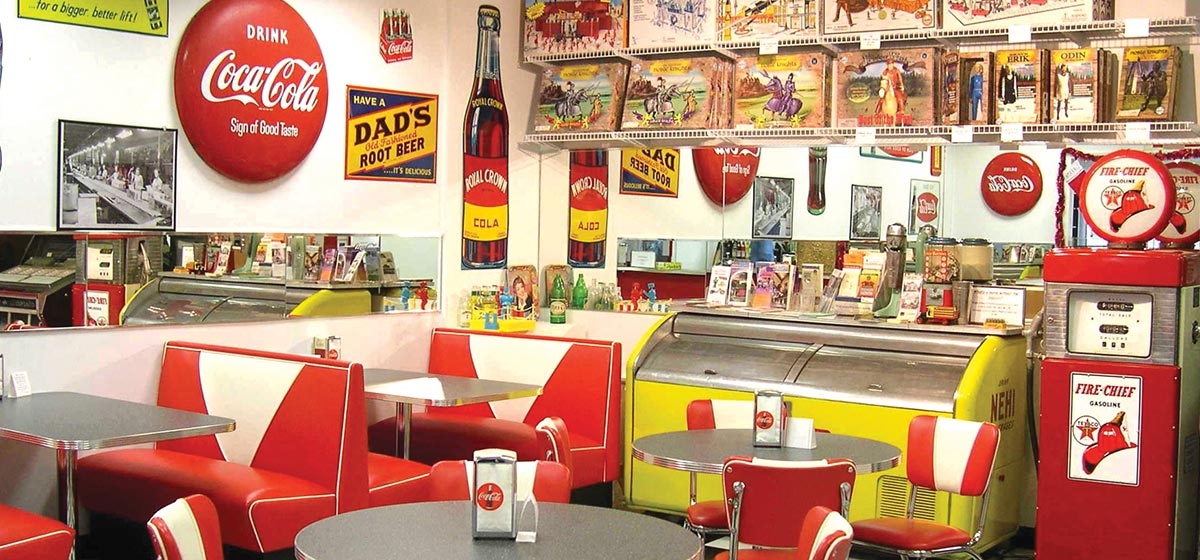Moundsville, W. Va.

As the holidays approach, frantic parents stand in endless lines or buy online, getting the hottest high-tech “made in China” toys. If that seems overwhelming, try visiting the Official Marx Toy Museum of Glen Dale, W.Va. Located in Moundsville, just south of Wheeling, the museum takes visitors down memory lane as they enjoy Louis Marx & Co.’s 50-year history.
Francis Turner, a toy dealer turned collector, opened the museum in 2001 after accumulating the most complete collection of Marx toys. Louis Marx established his company in 1919, opening factories in the mid-1930s in Glen Dale, Erie and Girard, Pa., and Birmingham, England. Early toys were metal, mechanical windups. Then came push toys, such as trucks and cars. During World War II, his factories supported the war, making shell casings, and he then started producing plastic toys. By the 1950s, Louis Marx & Co. was the world’s largest toy manufacturer, making over one-third of all U.S. toys. Featured on the cover of Time in 1955, Marx was declared the “Toy King” and “the Henry Ford of the industry” (due to his automation of the toy-making). The Glen Dale plant (about a mile from the museum) produced 80 percent of Marx’s toys. He sold the company in 1972, and it later went bankrupt.
The best-known Marx products displayed are the Big Wheel (produced at a rate of 7,000 daily at its peak), Rock ‘Em Sock ‘Em Robots and Johnny West action figures, but the company catalog was much more extensive with three main categories: everyday life, popular television shows and history.
Everyday life sets represented familiar settings: gas stations, kitchens, garages and farms. One farm set includes a crop duster add-on. (Imagine 1950s children pretending to spray DDT!) There’s a dollhouse with a fall-out shelter. Marx also pioneered licensed product tie-ins, with games and dolls representing TV shows “The Untouchables,” “Zorro,” “The Flintstones,” “Batman,” “The Archies” and “Yogi Bear.”
The detailed historical figurines and play sets extend from the dinosaurs through the space race, including the Alamo, Cuban missile crisis, Ben Hur, Custer’s Last Stand, WWII and the exploration of Alaska. Most toys displayed are in mint condition, with many in original boxes. Videos show old commercials for Marx toys, Marx’s life story and an AFL-CIO promo from the ’50s.
But alas, life is not all fun and games, and blocks away from the toy museum stands the West Virginia State Penitentiary. The Gothic-style prison has 24-foot walls, razor wire surrounds its 10-acre campus, and the stories told on the 1 1/2-hour tour are sobering.
The first phase of construction was completed in 1876, and in the first half of the 1900s, the prison was self-sufficient and fairly respected. Inmate employment was available at a library, school, farm, bakeshop and woodshop. Over time, conditions deteriorated. An expansion project doubling the prison began in 1929 and ended in 1959. This eliminated triple occupancy in the tiny cells — 5 by 7 feet with 6 1/2-foot ceilings. There was a “hole” used until 1973, with naked inmates, locked underground in the dark.
The prison was rife with rioting, murder and escapes (510 escapes between 1960 and 1995). While there were 94 executions through 1959 (85 by hanging and nine by electrocution in “Old Sparky,” on display), nearly 1,000 men died there during its violent history. There were 75 inmates per guard, but the inmates (mainly via a motorcycle-gang hierarchy) ran the place. Most cell doors show evidence of missing pieces of metal plates. Prisoners cut the metal into blades with dental floss and toothpaste and then honed knives on their concrete floors. Many cells display faux finishes, poetry, and condemnations of women who “landed them in jail.” Others painted waterfalls and soaring eagles.
The prison was perennially on the U.S. Department of Justice’s top 10 most violent correctional facilities list. Charles Manson requested that they let him transfer there from California. (Perhaps he felt a fondness for the place, since his mother was incarcerated there when they had a women’s building.)
In 1986, a judge ordered the facility closed since it violated federal regulations, including those against cruel and unusual punishment, but inmates remained until 1995.Today, it houses the National Corrections Law Enforcement Training and Technology Center, and each May, participants from 39 states and six countries hold mock riots and training. Regular tours are held April through November.
Completing a trip to Moundsville is a visit to Alexander’s on 7th, a restaurant in the former Mound City Bank. The 1907 building, beautifully restored by owner Karen Baker and her husband, is a lovely setting for a weekday lunch. Architectural details such as the original bank vault, the teller’s cage in the balcony and the ornate ceiling reinforce the town’s historical feel.
There are also Adena burial mounds at the Grave Creek Mound Archaeology Complex. Built between 250 and 100 B.C., the mounds (from which Moundsville gets its name) are the largest known burial mounds of this type. The 60,000 plustons of soil were moved by the Adena without horses or the wheel.




